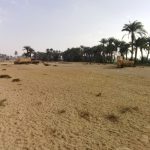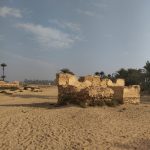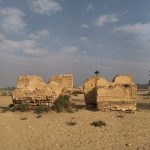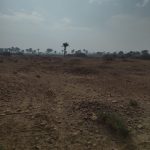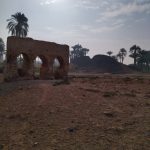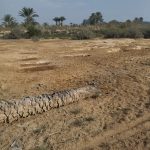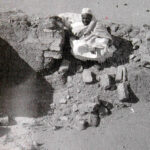ḪARABAT IHRĪT (THEADELPHEIA)
| Egyptian | Pȝ-ʿ.wy-n-sn.t | Trswȝ | *Tȝ-rsy |
| Greek | Θεαδέλφεια | Θρασω | Σαθρω |
| Arabic | بطن إهريت | خربة إهريت |
| English | Theadelphia | Batn el-Harit | Harit | Batn Ihrit | Kharabet Ihrit |
| French | Théadelphie |
| DEChriM ID | 52 |
| Trismegistos GeoID | 2349 |
| Pleiades ID | 737081 | PAThs ID | 121 |
| Ancient name | Theadelpheia |
| Modern name | Ḫarabat Ihrīt |
| Latitude | 29.347741 |
| Longitude | 30.564383 |
| Date from | -237 |
| Date to | 343 |
| Typology | Village |
| Dating criteria | Essentially papyrological, but also numismatic evidence. The earliest securely dated papyrus mentioning Theadelpheia dates to 230/229 BCE (P. Köln VIII 345), while the latest clearly dated ones date from 343 CE (SB VI 9622 = P. Sakaon 48) and 381/382 CE (P. Col. VIII 237) (Römer 2019: 110). |
| Description | Ancient Theadelpheia is situated on the western edge of the Fayyūm, some 7km south of the shore of Lake Moeris, and 30km north-west of Madīnat al-Fayyūm. There are a number of toponymic inconsistencies regarding the modern name of the site, which have resulted in confusions. Ḫarabat Ihrīt seems the most appropriate in minimizing such confusions (see Davoli 1998: 279 n. 485 for a discussion of this). According to papyri retrieved during fieldwork (Trismegistos records 1613 found in Theadelpheia), the site was inhabited between the third century BCE and the fourth century CE. Today, Ḫarabat Ihrīt is surrounded by cultivable land, with the kom having been completely flattened since the late 19th century (Davoli 1998: 279). There are only a few structures identifiable on the ground, including various houses, a temple, an area presumed to have been used for the processing of grapes, and a public bath, with the totality of the built-up area covering some 15 hectares. An extensive necropolis is situated to the west/north-west of the inhabited area, in which a few visible graves are identifiable. There are three distinct groupings of interments in the necropolis, with the oldest dating from 250-150 BCE (Davoli 1998: 287). Thousands of papyri have been retrieved from the site, including the Heroninos Archive, which is the largest surviving private archive from Roman Egypt. The papyri uncovered date from the Late Ptolemaic period to the reign of Augustus, while some 70 coins similarly range from the end of the Ptolemaic period to the period of Constantine (Davoli 1998: 281-282). Evidence of Christianity at the site are limited to attestations in these literary sources, including P.Sakon 48, wherein an individual identifies himself as the deacon of the church of Theadelpheia. |
| Archaeological research | Limited archaeological excavation has been conducted at the site. The first investigations were carried out by Grenfell and Hunt in 1899 around the same time when they were excavating at Euhemereia. This work, like that at Euhemeria, was dedicated to the discovery of papyri, and was thus of poor quality in terms of documentation. The men explored the inhabited center and the necropolis for a period of three weeks. Disappointed with the lack of papyri, they abandoned excavations after having only identified a temple and a number of houses. Two meagre publications resulted from their work, both of which were devoid of plans and descriptions (Grenfell and Hunt 1899; Grenfell, Hunt and Hogarth 1900, 51-61). They did, however, uncover some written documents, one of which enabled them to identify the site with the ancient locality of Theadelpheia (Grenfell and Hunt 1899: 12). After Grenfell and Hunt, ‘scientific’ exploration of the site commenced again in 1902 under the auspices of the Königliche Museen of Berlin, directed by O. Rubensohn. Like his forebearers, Rubensohn was actively dedicated to discovering papyri above anything else, with excavations conducted in a hasty fashion, without any real report being published (Rubensohn 1905). Based on the lack of objects found in the houses, Rubensohn concluded that the inhabitants of the village had left the site in an organised manner, taking belongings with them. Various clandestine excavations occurred in-between the officially sanctioned work, which brought to light numerous artefacts that ended up on the antiquities market, likely being the origin of the famed Heroninos archive (See: Rathbone 1991). Much of this material was published by Gustave Lefebvre, who at that time was the head inspector of the Service des Antiquités (Lefebvre 1910: 162-166; id 1914: 88-93; id 1920: 40-46, 54-56; id 1921: 163-165). The discovery of two Greek stelae at the site in 1908, found during such clandestine excavations, inspired Lefebvre, and later Evaristo Breccia in 1912-1913, to undertake excavations at the site. The work of both men was carried out with the intention of identifying the areas mentioned in the stelae: a temple dedicated to the crocodile god Pnepheros, the Bubasteion, and a crocodile necropolis. Lefebvre identified a structure as the temple of Pnepheros, but Breccia doubted his conclusion. Breccia later found the actual temple in 1912, and had the stone elements dismantled and reassembled in Alexandria at the Greco-Roman Museum. P. Jouguet and S. Yeivin appear to have visited the site on separate occasions, but they did not conduct any archaeological work. |
• Bagnall, R. S. 1980. “Theadelphian Archives.” Bulletin of the American Society of Papyrologists 17: 97-104
• Bagnall, R. S. 1970-1982. “The Population of Theadelphia in the Fourth Century.” Bulletin de la Société d'archéologie copte 24: 35-57.
• Barns, J. W. B. 1957. “A Fourth-Century Deacon’s Petition from Theadephia.” In Studia Patristica I, edited by K. Aland and F. L. Cross, 3-9. Berlin: Akademie-Verlag.
• Bernand, É. 1981. Recueil des incriptions grecques du Fayoum, vol. 3 (La ‘Méris’ de Polémon). Cairo: Institut français d’archéologie orientale.
• Bonneau, D. 1982. “Le drymos (δρυμός), marais du Fayoum, d’après la documentation papyrologique.” In L’Égyptologie en 1979. Axes prioritaires de recherches I, 182-190. Paris: Éditions du Centre national de la recherche scientifique.
• Breccia, E. 1918. “Theadelphia.” Bulletin de la Société archéologique d'Alexandrie 16: 91-118.
• Breccia, E. 1926. Monuments de l’Égypte gréco-romaine, vol. 1. Bergamo: Officine dell’Istituto Italiano d’Arte Grafiche.
• Casanova, G. 1975. “Theadelphia e l’archivio di Harthotes: ricerche su un villaggio egiziano fra il III a. e il I p.,” Aegyptus 55: 70-118.
• Casanova, G. 1979. “Il villaggio di Theadelphia e l’archivio di Harthotes. Addenda.” Aegyptus 59: 112-118.
• Davoli, P. 1998. L'archeologia urbana nel Fayyum di età ellenistica e romana. 279-293. Napoli: G. Procaccini.
• Davoli, P. 2012. “The Archaeology of the Fayum.” In Oxford Handbook of Roman Egypt, edited by C. Riggs, 152-170. Oxford: Oxford University Press.
• France, J. 1999. "Theadelpheia and Euhemereia. Village History in Greco-Roman Egypt." PhD thesis, Katholieke Universiteit Leuven (Trismegistos Online Publications).
• Grenfell, B. P. and A.S. Hunt. 1899. Graeco-Roman Branch: Excavations for Papyri in the Fayum; the Position of Lake Moeris. Archaeological Report (Egypt Exploration Fund 1898-1899), 8-15.
• Grenfell, B. P., A. S. Hunt and D. G. Hogarth. 1900. Fayûm Towns and Their Papyri. London: Offices of the Egypt Exploration Fund.
• Hagedorn, D. 1986. “Flurbereinigung in Theadelphia?” Zeitschrift für Papyrologie und Epigraphik 65: 93-100.
• Lefebvre, G. 1910. “Égypte gréco-romaine, II. Crocodilopolis et Théadelphie.” Annales du Service des antiquités de l’Égypte 10: 155-172.
• Lefebvre, G. 1914. “Égypte gréco-romaine, III.” Annales du Service des antiquités de l’Égypte 13: 87-108.
• Lefebvre, G. 1920. “Égypte gréco-romaine, IV.” Annales du Service des antiquités de l’Égypte 19: 37-65.
• Lefebvre, G. 1921. “Deux inscriptions grecques du Fayoum.” Annales du Service des antiquités de l’Égypte 21: 163-168.
• Maravela, A. and W.G. Claytor 2022. “Contributions to the Prosopography of Theadelpheia in the Second Century CE.” Tyche 37: 137-142.
• Nachtergael, G. 2000. “Sceaux et timbres de bois d’Égypte. I. En marge des archives d’Hèroninos: cachets et bouchons d’amphores de Théadelphie.” Chronique d’Égypte 75: 153-170.
• Kortenbeutel, H. 1937. Steuerlisten römischer Zeit aus Theadelphia. Berlin: Weidmannsche Verlagsbuchhandlung.
• Rathbone, D. W. 1991. Economies, Rationalism and Rural Society in Third-Century A.D. Egypt: The Heroninos Archive and the Appianus Estate. Cambridge: Cambridge University Press.
• Rathbone, D. W. 1994. “Settlement and Society in Greek and Roman Egypt.” In Proceedings of the 20th International Congress of Papyrologists, edited by A. Bülow-Jacobsen, 136-145. Copenhagen: Museum Tusculanum Press.
• Römer, C. 2019. The Fayoum Survey Project – The Themistou Meris Volume A – The Archaeological and Papyrological Survey, 105-172. Leuven: Peeters.
• Rubensohn, O. 1905. “Aus griechische-römischen Häusern des Fayum.” Jahrbuch des Deutschen Archäologischen Instituts 20: 47-48.
• Sharp, M. L. 1999. “The Village of Theadelphia in the Fayyum: Land and Population in the Second Century.” In Agriculture in Egypt from Pharaonic to Modern Times, edited by A. K. Bowman and E. Rogan, 159-192. Oxford: The British Academy.


 Json data
Json data


